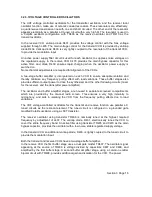
The circuit requires several changes of state of the switching transistors before the output
voltage r23V However, assuming a loss-less circuit with the oscillation starting with
TR201 conducting and TR200 off, then all capacitors C202, 0203, C205, C206 are charged to
approxi9V
On the second cycle when TR200 is on with TR201 off, both C205 and C206 have their
charge pumped to +18 volt due to the charge transfer from C202 and C203 respectively. C202
and C203 maintain their +9V charge in this cycle.
On the third cycle with TR201 on and TR200 off, C203 has its charge pumped to +18V by the
charge transfer from C205. C202 maintains its charge to +9V by current flowing from +9V
supply down through D200.
On the fourth cycle with TR200 on and TR201 off, C206 has its charge pumped to +27V by
charge transfer from C203. During this cycle C205 maintains its charge at +18V by charge
transfer from C202.
In practice, circuit losses and diode voltage drops result in +23 volt output rather than +27V
and the circuit takes more than 4 cycles to reach full voltage. However, because of the high
oscillation frequency the +23V output is available in less than 1mSec from application of the
+9V supply.
A high current 9-volt supply for the LCD backlighting is provided by TR215 which obtains its
bias voltage from TR214. In special systems applications it is necessary to provide the
microprocessor with an indication of the power off status although the equipment is
permanently powered on. This is provided by the output of the voltage divider R365, R366
connected to PIN 20 of the microprocessor. In the permanent power configuration link LK201
is fitted and LK202 is removed.
3.2.4.3
RESET
The PRM80 reset circuit monitors the radio supply voltage and performs the following
functions.
i)
Disable the radio for supply voltages less than 9.8 volts. Resume operation for
supply voltages of greater than 10.2 volts.
ii)
Generate an interrupt signal for the microprocessor during a low voltage
condition.
iii)
Generate a reset signal for the microprocessor after recovery from a low
voltage condition.
When the supply voltage is 13.8 volts, 5.1 volts is dropped across D225 leaving 8.7 volts
across R300. TR224 base emitter is reverse biased and D226 is conducting, hereby, limiting
this reverse bias. TR224, TR225, TR226, TR227 and TR232 are all biased off.
Therefore, the RESET output of the collector of TR227 is low (0 volt) and the interrupt at the
collector of TR225 is high (+5.2 volt). In this state the microprocessor is active.
Section 3 Page 19















































